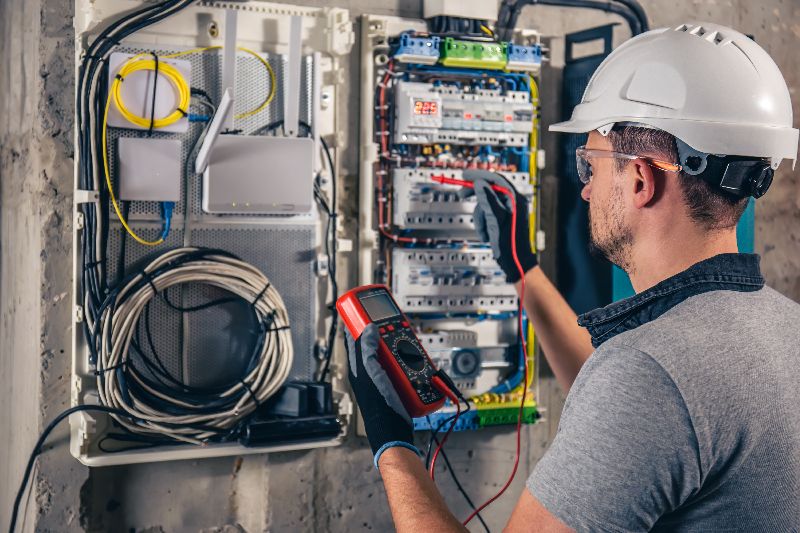
This syllabus provides a structured training program for individuals interested in learning the fundamentals of house wiring, electrical safety, installation techniques, and troubleshooting common electrical issues. The program emphasizes adherence to safety standards and codes.
1.1 Basics of Electricity:
Voltage, Current, Resistance, Power (Ohm's Law, Watt's Law)
AC vs. DC Electricity
Circuits: Series, Parallel, Series-Parallel
1.2 Electrical Safety:
Understanding electrical hazards (shock, fire, arc flash)
Lockout/Tagout procedures
Personal Protective Equipment (PPE)
First aid for electrical shock
1.3 Electrical Codes and Standards:
Introduction to National Electrical Code (NEC) or local electrical codes
Importance of compliance
Permits and inspections
1.4 Electrical Symbols and Schematics:
Common electrical symbols (outlets, switches, lights, breakers)
Reading and interpreting wiring diagrams
2.1 Wires and Cables:
Types of conductors (copper, aluminum)
Wire gauges (AWG) and ampacity ratings
Insulation types and color coding
Non-metallic (Romex) cable, conduit wiring, flexible cords
2.2 Overcurrent Protective Devices:
Fuses: Types and applications
Circuit Breakers: Types (thermal-magnetic, AFCI, GFCI), ratings, operation
2.3 Outlets and Receptacles:
Types (duplex, GFCI, tamper-resistant, USB)
Ratings and applications
Installation methods
2.4 Switches:
Single-pole, three-way, four-way switches
Dimmer switches, occupancy sensors
Installation and wiring
2.5 Lighting Fixtures:
Types of light bulbs (incandescent, fluorescent, LED)
Recessed, surface-mounted, outdoor lighting
Wiring and installation considerations
2.6 Electrical Boxes and Enclosures:
Types (junction boxes, outlet boxes, switch boxes)
Sizing and fill requirements
Mounting and securing
2.7 Grounding and Bonding:
Purpose and importance of grounding
Grounding electrode system
Equipment grounding conductors, bonding jumpers
3.1 Basic Hand Tools: Screwdrivers (insulated), pliers (lineman's, needle-nose, diagonal cutters), wire strippers, utility knife, tape measure, hammer
3.2 Measuring and Testing Equipment:
Multimeter (voltage, continuity, resistance)
Non-contact voltage tester
Circuit tester, GFCI tester
Cable tracer/toner
3.3 Power Tools (with safety emphasis):
Drills (corded/cordless)
Reciprocating saws, hole saws
3.4 Specialty Tools:
Conduit benders, fish tape, wire pullers
Crimping tools, termination tools
4.1 Planning and Layout:
Reading blueprints and floor plans
Load calculations for circuits
Determining receptacle and lighting locations
4.2 Rough-In Wiring:
Drilling holes, notching studs
Running non-metallic (Romex) cable
Installing electrical boxes
Stapling and securing cables
4.3 Finish Wiring:
Terminating wires at outlets, switches, and fixtures
Wiring light fixtures and ceiling fans
Installing cover plates
4.4 Service Panel Installation and Wiring (Basic):
Introduction to main service panel
Wiring circuit breakers
Bus bars, neutral bar, ground bar
Proper wire termination
4.5 GFCI and AFCI Protection:
Understanding where GFCI and AFCI are required
Installation and testing of GFCI receptacles and AFCI breakers
4.6 Branch Circuits:
Dedicated circuits (kitchen, laundry)
General purpose circuits
Circuit loading considerations
5.1 General Troubleshooting Methodology:
Systematic approach to diagnosing electrical problems
Safety precautions during troubleshooting
5.2 Common Electrical Problems:
Outlets not working
Lights not turning on
Circuit breaker tripping frequently
Flickering lights
Loose connections, faulty switches/outlets
Short circuits, open circuits
5.3 Using Testing Equipment for Diagnostics:
Identifying voltage presence
Checking for continuity
Locating opens and shorts
5.4 Repairing Damaged Wiring and Components:
Safely replacing outlets, switches, and fixtures
Repairing damaged insulation
Addressing loose connections
5.5 Basic Electrical Upgrades:
Adding new outlets or light fixtures
Upgrading switches
Troubleshooting existing installations for safety improvements
6.1 Smart Home Wiring (Basic Concepts):
Introduction to smart switches, outlets, and lighting
Network considerations
6.2 Low Voltage Wiring (Brief Overview):
Doorbell systems
Thermostat wiring
Data and communication cabling (basic)
6.3 Generator Transfer Switches (Introduction):
Manual and automatic transfer switches
Safety considerations
6.4 Home Electrical Inspections (DIY Perspective):
What to look for during a basic home electrical inspection
Common code violations
Written Examinations (covering theory, codes, and safety)
Practical Examinations (simulated wiring tasks, troubleshooting scenarios)
Blueprint Reading and Circuit Design Exercises
National Electrical Code (NEC) Handbook or local electrical code books
Residential wiring textbooks and guides
Manufacturer installation manuals for electrical devices
Online electrical training resources and videos
Electrical safety guidelines from relevant authorities